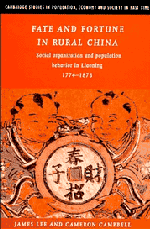Book contents
- Frontmatter
- Contents
- List of figures
- List of maps
- List of tables
- Acknowledgements
- PART 1 DAOYI VILLAGE
- 1 Prologue
- 2 Social organization and social mobility
- 3 Spatial and temporal setting
- PART 2 THE LIAONING DEMOGRAPHIC SYSTEM
- PART 3 HOUSEHOLD ORGANIZATION AND POPULATION BEHAVIOR
- PART 4 BANNER ORGANIZATION AND POPULATION BEHAVIOR
- EPILOGUE: PROSPECTS, IMPLICATIONS, AND COMPARISONS
- Appendices
- Glossary
- References
- Index
- Cambridge Studies in Population, Economy and Society in Past Time
3 - Spatial and temporal setting
Published online by Cambridge University Press: 20 October 2009
- Frontmatter
- Contents
- List of figures
- List of maps
- List of tables
- Acknowledgements
- PART 1 DAOYI VILLAGE
- 1 Prologue
- 2 Social organization and social mobility
- 3 Spatial and temporal setting
- PART 2 THE LIAONING DEMOGRAPHIC SYSTEM
- PART 3 HOUSEHOLD ORGANIZATION AND POPULATION BEHAVIOR
- PART 4 BANNER ORGANIZATION AND POPULATION BEHAVIOR
- EPILOGUE: PROSPECTS, IMPLICATIONS, AND COMPARISONS
- Appendices
- Glossary
- References
- Index
- Cambridge Studies in Population, Economy and Society in Past Time
Summary
Fate and fortune in rural Liaoning were subject not only to the broad organizational constraints of the Chinese household and the Manchu banner, but also to the specific ecological setting of the local climate and land. In Chapter 3, we locate the spatial and temporal setting of our population and show how three such ecological circumstances–the seasonal harvest cycle, the annual fluctuation in climate and prices, and a secular trend of rising demographic pressure–defined the boundary conditions of demographic and social behavior in Daoyi and surrounding communities. The demographic response to seasonal cycles and short-term fluctuations consisted of variations in vital rates. The response to the secular trend of rising Malthusian pressure, however, was not just a sum of individual demographic responses, but rather a fundamental transformation of the household and banner systems that radically changed the domestic context of daily life. In Daoyi, in other words, organizational constraints such as the household and banner systems were in turn shaped by ecological conditions.
The harvest cycle
Throughout the world, rural life is dominated by the passing of the seasons. Daoyi is no exception. Its extreme northern location guarantees a short, intense, agricultural season with only one harvest. Spring does not arrive until May, which brings little rain, but more sunlight than any other month of the year. The transition in the weather is rapid. Farmers accordingly have to rush to prepare their fields and plant their crops before the rainy season in July and August. This concentration of activity during the spring planting renews with the autumn harvest in September. Like the spring, the fall is quite brief–often no more than one month long.
- Type
- Chapter
- Information
- Fate and Fortune in Rural ChinaSocial Organization and Population Behavior in Liaoning 1774–1873, pp. 27 - 54Publisher: Cambridge University PressPrint publication year: 1997



